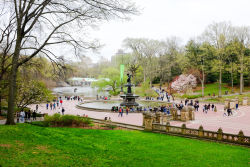Central Park
The Daily Plant : Thursday, October 17, 2002
THIS SPOT'S FOR THE BIRDS
Copacabana. Studio 54. The Limelight. New York City’s “in” spots are notoriously difficult to access, but they traditionally lose their glamour after a while. There is, however, one New York destination that you’ve probably never heard of—unless you “fly” with the right crowd. Situated on the East River between the Bronx and Queens, North and South Brother Islands have been growing in popularity since the Seventies with no end in sight. These two islands are regularly filled with diverse crowds from far and wide who arrive in large groups in search of food, conversation, and that special “someone.” Did I mention all these visitors are birds?
That’s right. Bird-watchers (or, as I call them, the paparazzi of the aviary world) have paid increasing attention to the uninhabited islands of New York City, including North and South Brother. Their renewed interest reflects the recent return of many native species of birds to the city as a result of environmental improvements and increased wildlife protection. Parks, working with state and national agencies and nonprofit groups, has helped renew natural environments and transformed New York City back into a destination for birds.
But the birds haven’t always had this good. In the early part of the 20th century, wild birds had become scarce in the city, and wildlife experts at the time observed a great decimation of wading bird populations. They attributed the drastic population decline to women’s fashion: bird feathers were an essential part of the millinery trade. Great egrets, for example, have special, long plumes that appear only during breeding season and which were very desirable. As a result, the birds were shot in large numbers and sold wholesale.
Around the 1930s, the National Audubon Society successfully lobbied for the enacting of national conservation legislation that would provide these birds with protection. It would take the better part of fifty years for the birds to return in sizeable numbers. In addition to legislation protecting birds, Parks has worked to secure and restore habitats for birds to make their homes in. Recently, Parks’ Urban Park Rangers, in conjunction with the Audubon Society, have applied for and been awarded $150,000 in grants for performing habitat improvements on North Brother Island. Working with Parks’ Natural Resource Group, they have performed extensive work on North Brother Island, including the selective removal of undesirable vegetation, the planting vegetation to increase bird habitability, the removal of debris.
Added to the early 20th century worries of the wading bird, North and South Brother Islands used to be dumps—literally. South Brother Island is believed to be the city’s first municipal dumpsite, filled primarily with household waste from the turn of the 20th century. North Brother Island, which is city-owned and has recently come under Parks’ jurisdiction, was the one-time home of Victorian-era quarantine facilities and was believed to house “Typhoid Mary” during her final living days. Because it was filled less high than North Brother, however, South Brother Island has been more subject to floods and, as a result, more desirable for wading bird populations. The dramatic rise in bird populations, however, has generated a spillover effect and North Brother Island is now a nesting and feeding site for many birds, as well.
In the 1970s, bird watchers noticed the return of birds to these “wild” islands. Over the past decade, Parks has acquired many of these natural lands, including Prall’s, Shooter, and North Brother Island. Parks will continue to help create welcoming homes and feeding grounds for these wading birds and ensure that New York City remains a hopping scene for New York City’s young and active birds.
Written by Eric Adolfsen
KING OF CONCESSIONS
Since he’s so special to those of us in the Arsenal, we decided to wait until the actual day to wish Isaac Mungalsingh a very happy birthday!
THIRTEEN YEARS AGO IN THE PLANT
(Thursday, October 26, 1989)
CENTRAL PARK TREE PLANTING TO COMMEMORATE
TREES THAT PERISHED IN ISRAELI FOREST FIRE
In southern Central Park, on the cold, misty morning of October 18, Mayor Edward Koch joined Ambassador Uriel Savir, the Consul General of Israel, and Moshe Rivlin, the world chairman of the Jewish National Fund, to plant three lace-bark pine trees in memory of the trees that perished in a forest fire on Mount Carmel, Israel last month.
Situated on the edge of a great desert, most of Israel’s forests have been reclaimed from the dry, arid land with great human effort. On September 19, 1989, the Israeli environment was dealt a cruel blow as one of its oldest forests, Mount Carmel, turned into a charred wasteland.
QUOTATION FOR THE DAY
"And in the end, it's not the years in your life that count.
It's the life in your years."
Abraham Lincoln
(1809-1865)
Check out your park's Vital Signs
Clean & Safe
Green & Resilient
Empowered & Engaged Users
Share your feedback or learn more about how this park is part of a
Vital Park System

Know Before You Go
Anticipated Completion: Spring 2024
Anticipated Completion: Spring 2025

Contacts
Central Park Information: (212) 310-6600
Central Park Information (for the Hearing Impaired): (800) 281-5722
Belvedere Castle, The Henry Luce Nature Observatory: (212) 772-0210
The Charles A. Dana Discovery Center: (212) 860-1370
The Dairy Visitor Center and Gift Shop: (212) 794-6564
North Meadow Recreation Center: (212) 348-4867
Loeb Boathouse (Bike rentals, boat rentals & gondolas): (212) 517-2233
Carousel: (212) 879-0244
Fishing at Harlem Meer (Catch & Release): (212) 860-1370
Harlem Meer Performance Festival: (212) 860-1370
Horseback Riding - Claremont Stables: (212) 724-5100
Metropolitan Opera (Performances on the Great Lawn): (212) 362-6000
New York Philharmonic (Performances on the Great Lawn): (212) 875-5709
Shakespeare in the Park - The Public Theater at the Delacorte Theater: (212) 539-8655
Central Park SummerStage: (212) 360-2777
Swedish Cottage Marionette Theater: (212) 988-9093
Tennis: (212) 280-0205
Weddings, Ceremonies and Photography at the Conservatory Garden: (212) 360-2766
Wildlife Center & Tisch Children's Zoo: (212) 439-6500











